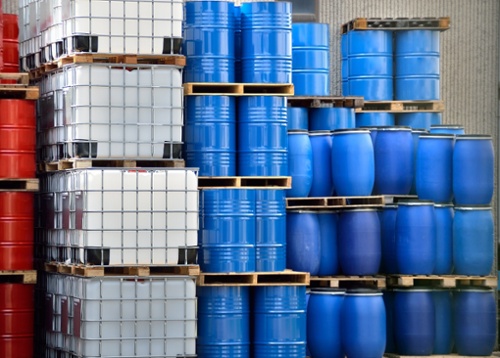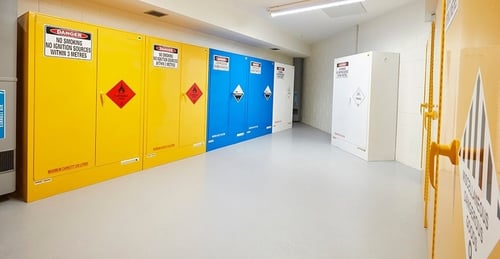Chemical hazards can be extremely complex — especially when the hazardous substances are also classified as dangerous goods. To fully understand how dangerous goods could harm your workers, property or the environment, you’ll need to do further research. In addition to reading your safety data sheets (SDS) and the product labels, the ADG Code is an essential reference for chemical safety. This post takes a quick look at how to use the Australian Dangerous Goods Code (ADG Code) to gain a better understanding of the chemical hazards at your worksite.
“Dangerous goods are subject to transport, workplace, storage, consumer and environment protection regulations, to prevent accidents to persons, property or the environment, to other goods or to the means of transport employed.” United Nations
What is the ADG Code?
The Australian Dangerous Goods Code is mandated by the National Transport Commission (NTC) of Australia. The Code sets out the technical instructions for safely transporting dangerous goods by road and rail.
The ADG Code uses the globally harmonised structure, definitions, and hazard classes set by the United Nations and is an important reference in Australian WHS Act and Regulations. Even though this document is the code for the transport of dangerous goods, it has a far-reaching relevance to workplaces who use chemicals. All dangerous goods require the correct labeling, storage, segregation and packing — before they are even loaded onto a truck, road vehicle or train.
Australian Dangerous Goods Classification
It’s essential to know if any of your chemicals are classed as dangerous goods.
Dangerous goods present an immediate danger to people, property, and the environment, so there is a real sense of urgency to understand the hazards and implement control measures. Plus, you’ll have additional compliance responsibilities in terms of the labeling, segregation and storage of these dangerous goods.
How to Find the Dangerous Goods Classification in the ADG Code
To find out if your chemicals are classed as dangerous goods, you can download the free ADG Code from the NTC website.
Go to Chapter 3.2: Dangerous Goods List in the ADG Code, and look up the name of the hazardous chemical. If you can’t find anything under the chemical’s common name, refer to the safety data sheet (SDS) to see if there are any known synonyms and alternative names.

Refer to the Dangerous Goods List within the code to see if the chemical is known as a dangerous good.
If your chemical is listed in the list, it will be recognised as dangerous goods. The class or division of your goods will be detailed in Column 3 of the DG List.
However, if there is no listing, the chemical may (in legal terms) still be dangerous goods if it meets the classification criteria — based on its physical and chemical properties.
If you have any doubts at all about the status of a chemical, you should always check with your supplier. Alternatively, speak with a professional consultant who specialises in dangerous goods.
NOTE: You can often determine if a substance is classed as dangerous goods from the Transport Section 14 of the safety data sheet.
Identifying Incompatible Substances and Segregation Alerts
Once you’ve identified if a substance is classed as dangerous goods, use the ADG Code to learn if you have additional legal responsibilities. Even if you don’t transport the chemicals and they always remain onsite, they will still need to be labeled, stored, and segregated according to the Code.
Segregation can be achieved when using various compliant storage cabinets to house each class of chemical.
The ADG Code lists each of the substances in a table format. Each substance is assigned a series of codes which indicate the hazard class, any subsidiary risks, labeling and packing requirements. This table will also indicate if there are limitations on the quantity you can carry, as well as any special provisions when storing in IBCs, portable containers, or bulk tanks.
You can also check Part 9: Segregation to determine if any of the substances have incompatibility risks.
Understanding Incompatible Chemicals
Substances can be incompatible in 3 different ways:
- The primary hazard of SUBSTANCE A is incompatible with the primary hazard of SUBSTANCE B
- The primary hazard of SUBSTANCE A is incompatible with a subsidiary risk of SUBSTANCE B
- A subsidiary risk of SUBSTANCE A is incompatible with a subsidiary risk of SUBSTANCE B
Once you determine if any incompatibilities exist, you will then need to check if there are any instructions for correctly segregating and storing the chemicals. Sometimes, there will be limitations on the quantities you can carry— or you may require a container made from specific materials.
Like to learn more about chemical segregation?
If incompatibilities exist, you may have additional responsibilities outlined in an Australian Safety Standard.
For example: if you are using any type of compressed gases you should be referring to AS 4332 - The storage and handling of gases in cylinders for instructions on segregating Class 2.1 Flammable Gases; Class 2.2 Non-flammable gases, non-toxic gases; and Class 2.3 Toxic Gases.
The ADG Code can help you identify other Safety Standards relevant to your business operations.
TIP: The ADG Code is not a document that you need to sit down and read every single word. It’s more effectively used it as a reference, like an encyclopedia of chemical risks and hazards. For example: you might use the pictorial guide to help you assess the integrity and safety of fuel or chemical drums that has been dropped and contains dents.
Storing, Handling and Transporting Dangerous Goods Safely
Now you know how to determine if the hazardous chemicals you hold on your premises are also dangerous goods, you may need to conduct a full risk assessment. Download our free eBook How to manage the risk of Hazardous Chemicals in the workplace to learn the 4-step process for identifying, assessing, and controlling hazards — then sustaining chemical compliance.
Joining the team as a Dangerous Goods Storage Consultant, Melissa Hampton became Storemasta's Marketing Manager in late 2021. With extensive knowledge and experience in chemical compliance, Melissa is responsible for leading the Marketing team and helping shape their marketing strategy. In her spare time, you can find Melissa hiking, swimming and enjoying the great outdoors in beautiful north-west Tasmania.

